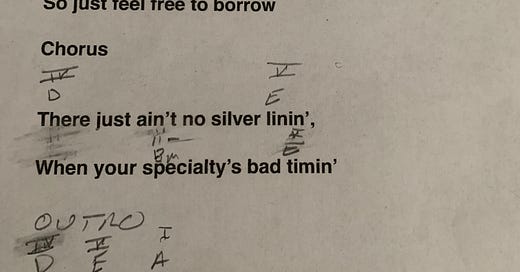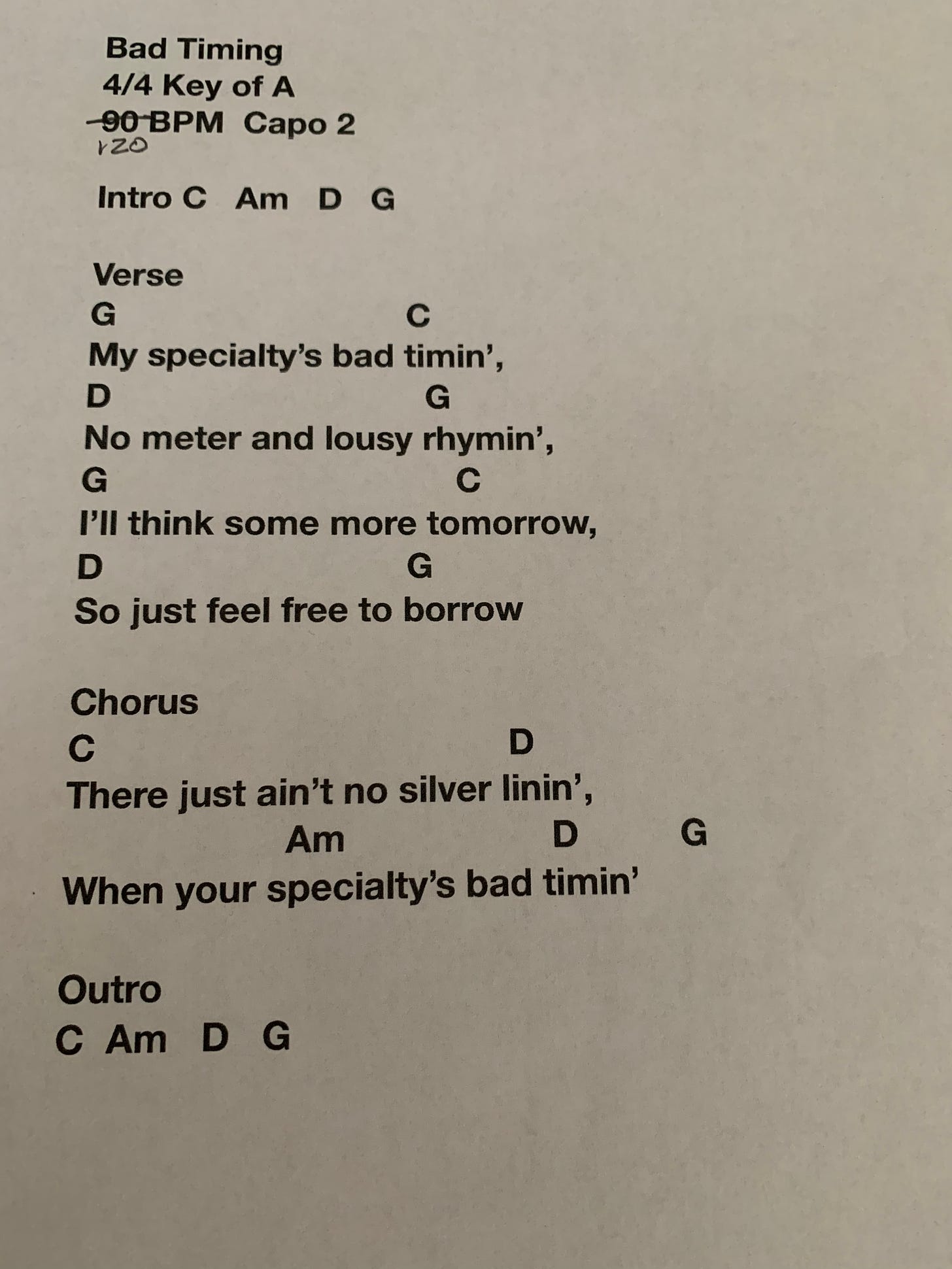Yesterday’s Bonus Round: Alison Krauss and The Union Station’s song “Borderline” off of the 2004 Album “Lonely Runs Both Ways” (which is a lyric from “Borderline”). Very cool and challenging song to play and sing!
Today we’re going to finish up the silly song we’ve been writing. It started with the thought “Bad timing my specialty” from my “odds and ends” note of random stuff I write down when said random stuff pops into my head. Long forgotten why I wrote it down, I resurrected it here as an illustration of “a”, but by no means “the”, process of writing a song.
So we did a syllable count and some phrasing, rhyme structure and a little rhythm analysis in previous weeks’ posts and came up with this for a verse:
Verse
My specialty’s bad timin’,
No meter and lousy rhymin’,
I’ll think some more tomorrow,
So just feel free to borrow
And a chorus:
Chorus
There just ain’t no silver linin’,
When your specialty’s bad timin’
It stayed that way (for now) through the remainder of yesterday as I wrote chord progressions for both.
I like to write in the Key of GMaj, but sing in AMaj (my voice tends to slide off the lower notes in GMaj, but AMaj and BbMaj - 2 and 3 semitones “above” GMaj, respectively seem to work for me). Since I like to play in GMaj, CMaj and DMaj, I wrote this in AMaj initially and noted the intervals. As I wrote yesterday in reference to the story about Elton John and Bernie Taupin’s “Your Song”, I pencil in the chord changes and much erasure and gnashing of teeth occurs. The initial chord chart looked like this:
I added a short intro and outro - I also added the interval notation (Roman numerals above the chord notation) so if I want to transpose to a key other than GMaj, it’s much easier to do. After playing different chord progressions for awhile I settled on what you see there, then, while remaining in the Key of A, capoed on the 2nd fret to use the chord shapes from GMaj, and reprinted the chord chart with the capoed chords, noting the capo position in the header. Like this:
I initially used an app called “Tap To BPM” to come up with a tempo of 90 BPM. I sang the song through a few times as I tapped out a 4/4 time on the screen, the app displays a sort of average BPM. I started at 90 BPM, with a fairly common strum pattern and quickly realized it needed to rock along a lot faster. I then used another app called Soundbrenner, which is a sort of audible and visible digital metronome. I use the “polyphonic” mode that produces a distinctive “tick” on the 1, and a different “tock” on the 2, 3, and 4 beats. Adjusting the timing of my strum and the Soundbrenner click eventually settled at 120BPM and sounded just about right, in that I was hitting the first syllable of each successive line on the 1 beat.
I actually recorded it as a voice memo, doesn’t sound too bad (for a voice memo), but I can’t figure out how to insert a “.m4a” file into this post. I’ll work on that for next week maybe.
Feel free to play, rewrite, change key, chords, lyrics, timing, anything you want. If you record it and figure out a way to insert audio clips, let me know!!
Next week we’ll spend a little time with “what now?” - caution, we’ll be dipping our toes into the brutal and sometimes very weird world of the “music industry” - a much more frightening place than music theory, by far!!
Bonus Round: A 1970 song, covered many times by others, by a singer with a distinctive vibrato voice. Comment on the music industry maybe?
Cheers, and keep playing!!
Michael Acoustic






